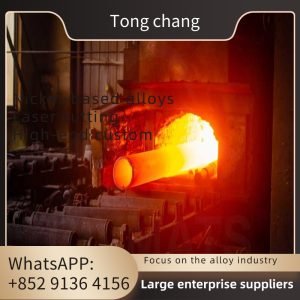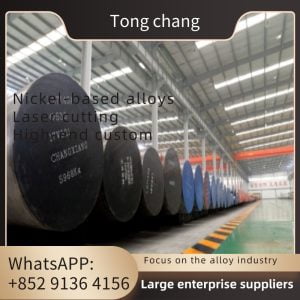| Product Name: | Tubesheet | Standard: | ASTM A182, ASME SA182, ASTM A516, ASME SA516, Etc |
|---|---|---|---|
| Material: | Alloy Steel, Stainless Steel, Carbon Steel, Copper Steel | Size: | Can Custom, As Buyer’s Drawing Requirements |
| Shape: | Cylinder | NDT: | 100% PT, UT, PMI |
| Application: | Tubular Heat Exchanger, Boiler, Pressure Vessel, Steam Turbine, Large Central Air Conditioning, Etc. | ||
| High Light: | Carbon Steel Heat Exchanger Tubesheet, Forged Heat Exchanger Tubesheet | ||
Stainless Steel , Carbon Steel Tubesheet for Heat Exchanger Parts
TONG CHUANG Group has specialized in tubesheet manufacturing for many years. We can supply tubesheet as per clients' requirement with grades of carbon steel, stainless steel, duplex steel, copper, nickel alloy. A tubesheet is a critical component used in shell and tube heat exchangers, boilers, and other types of equipment that involve the transfer of heat between fluids. It acts as a structural support and provides a means of sealing and securing the tubes in place.
Some key points about tubesheets:
1. Construction: Tubesheets are typically made of metal, such as carbon steel, stainless steel, or various alloys, depending on the application and operational conditions. They are often thick and robust to withstand high pressures and temperatures.
2. Tube Arrangement: Tubesheets have precise holes or tube seats drilled into them, where the heat exchange tubes are inserted and mechanically attached. The arrangement of these holes can vary depending on the design and purpose of the equipment.
3. Tube-Sheet Joint: The joint between the tubes and the tubesheet is crucial for maintaining a leak-tight seal and mechanical integrity. Common methods of tube-to-tubesheet attachment include welding, rolling, or expansion. These techniques ensure a secure connection while maintaining efficient heat transfer.
4. Fluid Flow: The tubesheet serves as a barrier, separating the fluids being processed in the shell side and the tube side of the heat exchanger. The design of the tubesheet takes into account the fluid flow rates, pressure differentials, and temperature differentials to ensure effective heat transfer.
5. Maintenance and Repair: Over time, tubesheets may experience wear, corrosion, or fouling due to the fluids' nature and operating conditions. In such cases, it may be necessary to replace damaged tubes or repair the tubesheet to maintain the equipment's performance and integrity.
Material Grades of Tubesheet
Type of materials | Technical requirements according to |
Duplex Stainless Steel | ASTM/ASME SA182 F44, F45, F51, F53, F55, F60, F61 |
Stainless Steel | ASTM/ASME SA182 F304,304L,F316,316L, F310, F317L, F321, F347 |
Carbon Steel | ASTM/ASME A105, A350 LF1, LF2, A266, A694, A765 Gr.2 |
Alloy Steel | ASTM/ASME SA182 F1, F5, F9, F11, F12, F22, F51, A350-LF3 |
Titanium | ASTM/ASME SB381, Gr.1, Gr.2, Gr.5, Gr.7, Gr.12, Gr.16 |
Copper Nickel | ASTM/ASME SB151, UNS 70600(Cu-Ni 90/10), 71500(Cu-Ni 70/30) |
Brass, Al-brass | ASTM/ASME SB152 UNS C10100, C10200,C10300,C10800,C12200 |
Nickel Alloys | ASTM/ASME SB169,SB171, SB564, UNS 2200, UNS 4400, UNS 8825 |
Alloy 20 | ASTM/ASME SB472 UNS 8020 |
Hastelloy | ASTM/ASME SB564, UNS10276 ( C 276 ) |
Claded materials | ASTM/ASME SB898, SB263, SB264 or closer |
Titanium- Steel, Nickel-Steel,Titanium- Copper, |
Standard: ANSI/ASME B16.5, ANSI/ASME B16.47, BS4504, BS3293, EN 1092, DIN2631,DIN2632,DIN2633, DIN 2634, DIN2635, DIN2636, DIN2637, DIN2638, JIS B2220, SABS / SANS 1123 , GOST / ГОСТ 12821-80 Flange, MSS SP-44 FLANGE, API 6A, 6B, 6BX weld neck FLANGE, ISO 7005 Weld neck flange. NFE 29203 Weld neck flange, KS B1503 , UNI 2280-67 ,UNI 2281-67 ,UNI 2282-67 ,UNI 2283-67 , UNI 2284-67, HG20595, AS2129.
Face America Series: Flat face(FF),Raised face(RF),Tongue(T),Groove(G),Female(F),Male(M),Ring type joints face(RJ/RTJ)
Europe Series: Type A(Flat Face),Type B(Raised Face),Type C(Tongue),Type D(Groove),Type E(Spigot),Type F(Recess),Type G(O-Ring Spigot),Type H(O-Ring Groove)
Pressure America Series: Class 150 ,Class 300, Class 600, Class 900A ,Class 1500,Class 2500.
Europe Series: PN2.5,PN6,PN10,PN16,PN25,PN40,PN63,PN100,PN160,PN250,PN320,PN400.
Manufacturing Process
ingot billet &round bar– chemical element analizing—bandsaw cutting—forging—heat treatment—inspection–stock of unmachined blanks—lathe—-deep hole drilling—inspectction—marking—packing with plywoodcase
It's important to note that the selection of materials for a pressure vessel should be made based on a number of factors, including the specific application requirements, design considerations, and applicable codes and standards. A qualified engineer or materials specialist should be consulted to ensure that the appropriate materials are selected for the application.
Some common applications of tubesheets:
1. Heat Exchangers: Tubesheets are widely used in shell and tube heat exchangers, which are devices designed to transfer heat between two fluids. The tubesheet holds the heat exchange tubes in place, allowing efficient heat transfer between the fluids.
2. Boilers: In boilers, tubesheets are employed to support and secure the tubes that carry hot gases or water, allowing heat transfer for steam generation or hot water production. They play a critical role in maintaining the structural integrity of the boiler's tube bundle.
3. Condensers: Tubesheets are utilized in condensers, which convert steam or vapor into liquid form. The tubesheet provides a secure attachment for the tubes, allowing efficient heat transfer and condensation of the vapor.
4. Reactors: Tubesheets are employed in chemical reactors, particularly in tubular or shell and tube reactors. They provide support for the reactor tubes and allow controlled heat exchange between reactants or products within the tubes and the surrounding environment.
5. Oil and Gas Industry: Tubesheets are used in equipment such as oil coolers, oil heaters, and oil refineries. They facilitate heat transfer between various process streams, helping to cool, heat, or separate different components in the oil and gas refining processes.
6. Air Conditioning and Refrigeration: Tubesheets are essential components in air conditioning and refrigeration systems. They are used in condensers, evaporators, and heat exchangers, helping to transfer heat between the refrigerant and the surrounding air or water.
These are just a few examples of tubesheet applications. Tubesheets have widespread use in industries that require efficient heat transfer between fluids.






